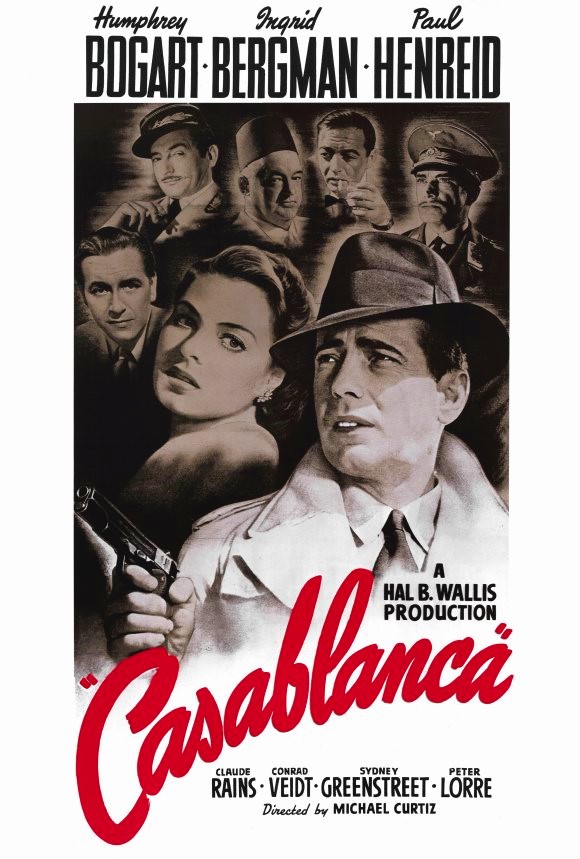Hollywood - Casablanca
The studio system

From the 1920s to the 1950s, Hollywood was dominated by eight major studios.
- The 'Big Five' consisted of MGM, Warner, Paramount, RKO and Fox, who produced and distributed films, and also owned cinemas.
- The ' Little Three' consisted of Universal, Columbia and United Artists. These did not own their own cinemas.
These studios controlled distribution of 95% of films shown in the US.
The Big Five were vertically integrated, meaning that they controlled the production, distribution and exhibition of their film. This gave them complete creative control.
Commercial features were produced on studio lots. The cast and crew worked under contract.
Each studio developed a house style, determined by it's chief executives. In this way, it could be argued that the director had less autonomy over the films. This might amount for the fact that Casablanca's director, Michael Curtiz, is by no means a household name, even though he directed one of the greatest films in cinematic history.
Warner Bros. traits
- big-screen realism
- generated a cycle of gangster films and crime dramas: in 1931 alone there was Little Caesar, starring Edward G Robinson; The Public Enemy, starring James Cagney; and Smart Money, which starred them both.
- films chimed resoundingly with the spirit of the times. They held up a mirror to Depression-era America, and appealed directly to ordinary people suffering financial troubles.
- These Warner Bros films developed a house style: urban settings, snappy dialogue and a brisk pace, with scripts and performances that never strayed into sentimentality.
- Executive producer : Jack Warner
Jack Warner entered the film business with three brothers, Harry, Albert and Samuel, in the early 1900s. Jack was critical of the nazi reigeme and became fully commited to the war effort. Along with his brother they developed the warner style.
- Producer: Hal B. Wallis
Wallis was responsible for putting together the budgets and recruiting actors, directors and personnel for each film he produce at Warmers. Wallis developed the idea for Casablanca, buying the film's rights for $20,000. He closely supervised the production of casablanca and even wrothe the final line :"Louis i think this will be the start of a beautiful friendship".
Director: Michael Curtiz
Curtiz was ab Austrian emigrè who was based at Warners for most of his career. He directed over 100 films for them, including some of their biggest hits. Curtiz was a highly regarded, efficient and accomplished commercial director who could turn his hand to different genres.
Three notable films directed by Michael Curtiz and Warner Brothers:
- The Adventure of Robin Hood (1938)
- Angels With Dirty Faces (1938)
- Mildred Pierce (1945)
Although Curtiz is not usually considered an auteur in the same sense as Hitchcock and Welles, film scholar Sidney Rozenweig Identifies Curtiz style as:
Cinematographer: Arthur Edeson
Arthur Edeson was an acclaimed Hollywood cinematographer. He was contracted to Warners fairly late in his career, from 1936 to 1947. It is considered by many film critics to be the first film noir.
Composer: Max Steiner
Max Steiner was a Vienna born composer who created Hollywood film scores for 300 films in the 1930s to the 1960s. The musical scores Steiner composed for over the credits of films were highky dramatic and set the tone for the whole film.
Institutional contexts
Casablanca is a hybrid of two popular genres produced at Warner Brothers: the film noir and the melodrama. All the key talent who produced the film were on contract at Warner Brothers, including the director, produced the film were on contract at Warner Brothers, including the director, producer and cinematographer (Discussed in detail in the auteur section of this chapter) as well as popular actors in major in minor roles).
Political, social and cultural contexts
For film scholar Thomas Schatz, Casablanca is 'an anthem of America's commitment ot the war'. To fully understand Casablanca, it is therefore important to have some knowledge of the political events of the time, as they are integral to the film's plot.
Casablanca was a french colony and became a holding place for refugees escaping Nazi rule while attempting to get exit visas to Lisbon, Portugal.
Rick is the embodiment of the USA's initial reluctance to enter the war.
Introduction to essay.
(b) The production of Casablanca could be viewed as one of
the films that contributed greatly in the rise of classical Hollywood film
form, and aided in its entrance into the mainstream. It reflected the sheer
power, influence and momentum which Warner Brothers studios began to exert, despite
the fact the studio was only at the beginning of it’s climb to it’s partial
control of the modern film industry today.
During this time, Hollywood's success was based on telling
stories clearly vividly, entertainingly. The techniques of continuity editing,
set design, and lighting that were developed during this era were designed not
only to provide attractive images but also to guide audience attention to
salient narrative events from moment to moment.
In term of it's ending, the film shares a lot of common traits with the ending.

Notes are okay, essay on Casablanca not done.
ReplyDeleteMr Boon